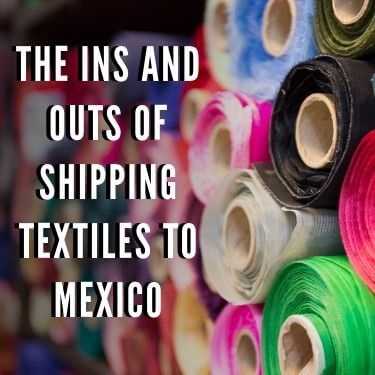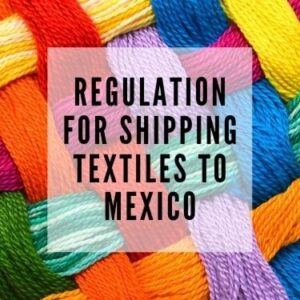
Por
 Copiar URL al Portapapeles
Copiar URL al Portapapeles
Shipping textiles to Mexico is a big business. In 2017 alone, the U.S. shipped $4.13 billion worth of textiles into Mexico! However, even though the two countries share a land border, shipping between them is not as easy as it might seem. Without a solid understanding of the trade agreements and customs regulations, you could be setting your shipment up for failure! Thankfully, the regulations are not difficult to comply with once you understand them.
Because of NAFTA and USMCA, textiles and textile products can qualify for duty-free shipping into Mexico. However, there are many more things to know about shipping textiles to Mexico, like import documents, border compliance, and customs brokerage.
Table of Contents
 Regulation for Shipping Textiles to Mexico
Regulation for Shipping Textiles to MexicoIn order to export textiles to Mexico, you’re going to need to be familiar with all the documents involved in the process. Although much of the responsibility would fall on the importer of the goods, it is important to maintain open communication with the importer and to understand the documents involved on both sides of the exchange.
In order for U.S. goods to enter Mexico, they will need to be accompanied by a number of documents. These documents are:
These documents must be in Spanish, along with any labels, tags, and other printed materials.
Since 1994, importers in Mexico could rely on the North American Free Trade Agreement (NAFTA) to import goods between Mexico, the U.S., and Canada without the burden of tariffs imposed on the shipment, and other trade barriers. However, things are changing under President Trump’s administration. A new agreement was signed by the three countries in September of 2018: The United States-Mexico-Canada Agreement (USMCA).
If you’re like many people shipping textiles to Mexico, you’re probably wondering how the new USMCA regulations are going to affect your business. Thankfully, they are not much different from the original NAFTA regulations, but there are some changes regarding textiles specifically.
NAFTA and USMCA are similar in the sense that they both depend on what’s called the “Rule of Origin.” In order to qualify for the benefits offered by the agreement, textiles and apparel must be produced primarily by one of the three countries involved in the agreement.
Some changes to the agreement include a number of new requirements for details on textile products. Previously, these details were permitted to be from materials made outside one of the countries in the agreement, but the USMCA now requires that they also are included in the rule. This includes:

There are exceptions to the rules, however. The “Yarn Forward” exception is one example of that. This exception, also known as “Triple Transformation,” means that fibers can be sourced from outside the USMCA countries, as long as they are spun, woven, and assembled all within one of those countries. Non-originating fibers should also not make up more than 10% of the overall weight of the main part of the product.
As the exporter of textile products, you would need to verify the components of your products with a questionnaire, in order to get issued a statement to certify that it qualifies for duty-free treatment.
Once you know the regulations for shipping textiles to Mexico, you’re still going to need to get it through the U.S. Mexico border. The port of entry in Laredo, Texas is one of the most highly traveled ports between the U.S. and Mexico, but even there, you should be prepared for the shipment to get held up. Not only does it take time to process every vehicle that moves through the border, but your textiles may also be subject to inspection.
If your shipment of textiles claims to be entitled to the preferential tariff treatment under USMCA, then the Customs and Border Protection (CBP) and the Mexican Customs agents will want to verify that statement. Additionally, they will survey the commercial invoice and compare it to the contents of the shipment, to ensure that everything is accounted for correctly. If there is a mistake in the documentation, that could result in your shipment being seriously delayed.
Wait times for border crossing varies tremendously based on several factors, like traffic, weather, and if your shipment is selected for inspections. Even if it is likely that your shipment will pass through quickly, you should be prepared to deal with delays.
When selecting a shipping service for transporting your freight, you should make sure that your carrier is experienced with transporting freight across the U.S.-Mexico border. There are many things that could go wrong, which could get your shipment caught up in customs. In the shipping business, time is money, but you may also be charged a fee by the CBP if your shipment is documented incorrectly or otherwise improperly managed.
To avoid complications, it is always best to use a carrier that is reliable and experienced. A third-party logistics company is often the safest and most cost-effective way of finding the right carrier for the job and comes with the added benefit of being a point of communication between the shipper and the carrier.
If you’re shipping textiles to Mexico, working with R+L Global Logistics can make the process easier! We can get you in touch with experienced, trusted carriers that will treat your shipment with the utmost care. We offer expedited services and real-time freight tracking, so you can get your shipments delivered on a time-sensitive basis. We also offer solutions to any of your logistics problems, including warehousing, customs brokerage services, and supply chain management. Our multilingual experts can guide you through the process, and answer any questions you may have. If you have freight to ship like medical devices, shoes and more, contact us to request a quote!
 Copiar URL en el Portapapeles
Copiar URL en el Portapapeles
